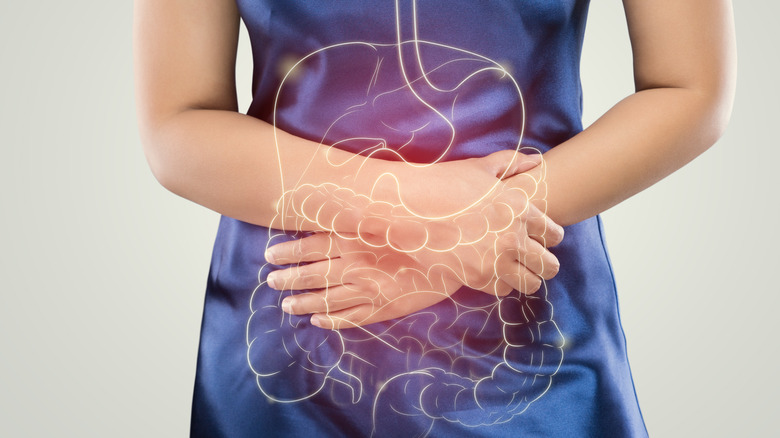Peptic Ulcer Versus Gastritis: What's The Difference?
It's scary when two health conditions are similar, leading to worry, doubt, and misdiagnosis in addition to the condition's symptoms. Here's a breakdown of two similar conditions — peptic ulcers and gastritis — and how they differ.
Peptic ulcer disease (PUD) involves sores forming within the stomach or first piece of the small intestine called the duodenum, reports Cleveland Clinic. The stomach lining is usually covered by a layer of mucus that protects it from degradation from stomach acid. Once this layer is reduced enough, an ulcer can form on the lining.
The most common causes of peptic ulcers are the heavy or long time use of NSAID pain relievers and H. pylori, which infects the stomach.
Symptoms can include burning in the middle or upper stomach, bloating, nausea, vomiting, dark stool, and pain that dissipates with antacid use.
To diagnose PUD, you will likely be tested for H. pylori using breath, blood, or stool tests, or sampling taken during an endoscopy. In an upper endoscopy, a small tube with a camera will be sent down the throat to look for anything abnormal in the stomach.
Peptic ulcers are treated with medications, including antibiotics to eliminate H. pylori and histamine receptor blockers (H2 blockers) or proton pump inhibitors (PPIs), which reduce acid. Medications that coat the ulcer to protect the stomach lining from further damage may also be used. Ulcers can usually be resolved within weeks by treating the cause behind them, but they can reoccur.
But how does gastritis, another stomach issue, differ from peptic ulcer disease?
How gastritis differs from peptic ulcer disease
According to the Mayo Clinic, gastritis is the inflammation of the stomach's lining. Like PUD, gastritis involves weakening the mucus lining that protects the stomach from acids.
The causes of gastritis are strikingly similar to PUD, as well, with bacterial infections, NSAID pain reliever usage, and heavy consumption of alcohol being the most common.
Although there may not be symptoms like PUD, common symptoms include fullness in the abdomen after eating, nausea, vomiting, and pain in the upper abdomen. And, if gastritis is left untreated, it can lead to ulcers.
Gastritis is diagnosed essentially the same as PUD. Your healthcare professional will test for H. pylori using a stool or breath test, perform an endoscopy to examine the stomach and small intestine for inflammation, or take X-rays of the upper abdomen, often using a liquid to reveal damaged areas.
Once gastritis has been determined as the issue causing your symptoms, the doctor will prescribe medication based on the test findings. As with PUD, PPIs and H2 blockers are prescribed to reduce stomach acid. Antibiotics will be prescribed if it is determined H. pylori is the cause of the inflammation. Lastly, antacids may be used supplementally to treat immediate symptoms.
While the conditions are similar, they are not the same especially as gastritis can worsen and essentially lead to PUD. It is best to see a doctor if you are experiencing any of the common symptoms so they can properly diagnose and treat the underlying cause before ulcers develop.


